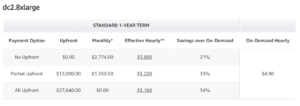

Today’s cloud data platforms have to be simple to use and provide an intuitive user experience while not sacrificing key features and functionality. There are plenty of AWS regions to choose where you want to run Redshift Serverless. Redshift Serverless is available across a wide range of AWS regions in North America, EMEA, and APAC. If you are worried about limited availability in your region, don’t be. Unlike a provisioned cluster which requires thought and planning for a maintenance window and typical activities such as patching, you don’t have to deal with that at all with Redshift Serverless as those types of activities are handled in the background for you. Planning for maintenance, patches, upgrades (or not) Data storage costs still apply as Redshift Managed Storage (GB/Month) and the data volumes stored.

I know that billing will be based on how much capacity (RPUs) is used during a given timeframe by the second (minimum charge is for 60 seconds, metered on a per-second basis). I see a big-time benefit in that you only pay for Redshift Serverless when queries are run thereby alleviating the burden of manually pausing and resuming your cluster in order to optimize costs. This was mentioned earlier, but it’s worth repeating as this isn’t possible with a provisioned cluster. What about pausing and resuming (and its cost impact) I mainly used the sample_data_dev database and the tpcds sample dataset in my initial testing.Ĭreate your own alarms for a workgroup, namespace or snapshot storage. I mainly used the sample_data_dev database and the tpcds sample dataset in my initial testing.Redshift Serverless also starts up a sample database with multiple sample datasets to test and run queries against.

The first time connecting to the Query Editor v2 to Redshift Serverless took about 60 seconds in my case and took just a few seconds each time afterward.Redshift Serverless also starts up a sample database with multiple sample datasets to test and run queries against. There’s no problem with options to start running queries. Whether you left your RPU base capacity at the default (128) or opted to make a change, now it’s time to do some processing so jump into the Redshift Query Editor v2 which you can access from the side menu, the serverless dashboard, the namespace, the workgroup - you get the idea. Additionally, you don’t need to worry about pausing and resuming (like you do with provisioned clusters) in order to optimize costs since you only pay for Serverless when queries are run. As it relates to concurrency, Redshift Serverless automatically adjusts resources and scales as needed based on workload activity and the cost control limits that you set as thresholds. The general guidance from AWS is that increasing your RPU base capacity will improve query performance. I’ll give you my perspective and first impression after recently taking Redshift Serverless for a hands-on spin.Ĭhanging your RPU base capacity - status is “Modifying.” This is an impactful option for everyone in the AWS data ecosystem and delivers a simple, fast, and operationally sustainable way to deliver data outcomes. In the case of Redshift Serverless, as a data analyst, data engineer, analytics engineer, data scientist or virtually any data professional, data products and data applications across multiple data workloads can be developed, built and run without the need or overhead to design, provision, and manage data warehouse clusters. Broadly speaking, a serverless-based approach to computing is considered cloud-native and eliminates the need for users of computing resources to get involved in provisioning and ongoing management of the compute infrastructure, effectively reducing infrastructure effort. I was excited to see this release since I had been mentioning this capability to clients in my previous consulting role since the public preview announcement last November.

Amazon Redshift Serverless became generally available in July 2022.


 0 kommentar(er)
0 kommentar(er)
